The president’s decision to violate the Joint Comprehensive Plan of Action (JCPOA) with Iran by indicating U.S. intent to reimpose sanctions and withdraw from the agreement has been rightly condemned as a mistake.
Some supporters of the Iran nuclear deal have taken comfort from the fact that, in taking the United States out of the JCPOA, Donald Trump did not simultaneously launch the snap-back of U.N. Security Council (UNSC) sanctions against Iran. They have suggested that this will protect the JCPOA for a bit longer and, simultaneously, avoid demonstrating how isolated the United States is at the U.N. Security Council.
All of this may be true and, for the time being, keeping Security Council involvement at bay may be in the best interests of both the agreement and the United States. Yet, the failure to pursue snap-back at the UNSC ceded significant leverage that the United States could have used now and that the international community may wish to have in the future, compounding the damage of this hasty decision.
UNSC resolutions before and during the JCPOA
Since July 2006, the UNSC has adopted four resolutions imposing sanctions on Iran in response to concerns about its nuclear and missile programs. Five are particularly salient:
- A binding prohibition on the supply of nuclear technology to Iran;
- A binding prohibition on Iran’s export of any item on the Nuclear Suppliers’ Group lists of controlled and dual use goods;
- A binding prohibition on providing Iran with services related to Nuclear Suppliers Group-controlled or dual-use items;
- A binding prohibition on the supply of any item on the U.N. Register of Conventional Arms, which includes most significant military hardware, as well as support and services with respect to these arms; and,
- A binding prohibition on Iran’s activities with respect to “ballistic missiles capable of delivering nuclear weapons” as well as on states provision of “technology or technical assistance to Iran related to such activities.”
When the Iran nuclear deal negotiations concluded, the UNSC decided to adopt a new resolution (UNSCR 2231) that would replace the previous ones. It phased out the conventional arms- and missile-related prohibitions in five and eight years, respectively, and changed the nuclear prohibitions from a blanket set of denials to a somewhat more permissive regime. This would require Iran and those exporting nuclear goods to Iran to submit export applications to a procurement channel that would guard against illicit Iranian nuclear traffic and ensure that JCPOA members could scrutinize any of Iran’s nuclear-related procurement. This requirement would phase out in 10 years, when the UNSC’s mandate over Iran was scheduled to expire.
The adoption of UNSCR 2231 and its contents were highly controversial, and critics charged that it badly compromised the international framework for confronting Iran. In particular, they expressed concern that the JCPOA and UNSCR 2231 would enable Iran to acquire conventional arms and missiles without restrictions after the expiration dates. They also took issue with the procurement channel, arguing that it had structural deficiencies and pointing out that the requirement to use it would one day lapse. Many of these critics championed the “fix or nix” approach (that the president ultimately resolved on May 8 in favor of “nix”), in part on the basis of these critiques. Perhaps more fundamentally, JCPOA critics said that the core error of the nuclear deal was that it eliminated a legal prohibition on Iran’s ability to enrich uranium and process plutonium—established in UNSCR 1737 in December 2006—in favor of the more permissive approach in the JCPOA.
Taking aside whether these criticisms are accurate, fair, or valid, they were a major part of the argument against the JCPOA in 2015.
Snapback?
One would have thought, therefore, that the Trump administration would have been eager to reverse UNSCR 2231 and to re-establish the UNSC-mandated sanctions regime that existed prior to July 2015. Ambassador Nikki Haley’s efforts to draw attention to Iran’s activities in Yemen, though thus far unpersuasive according to other U.N. missions with whom I have spoken, also demonstrate that some in the U.S. government still see the value of multilateral cooperation.
Without question, snap-back was within Washington’s reach, since the JCPOA and UNSCR 2231 allowed any permanent UNSC member to reimpose UNSC sanctions on its own (as paragraphs 36 and 37 of the JCPOA make clear), after a process lasting 60 to 80 days. The United States insisted on these provisions in 2015 to address the complaint of JCPOA critics that, without such a snap-back, the United States would be at the mercy of Russia, China, and perhaps European partners too invested in commerce with Iran to hold Iran accountable for JCPOA violations.
These were arguably the most deferential powers the UNSC could put in the hands of the United States—something an “America First”-obsessed president should like. That the United States would not use these powers, even at the expense of another 60 to 80 days in the JCPOA, is surprising. It suggests the president (and perhaps the national security advisor) were so desperate to withdraw the United States from the agreement as fast as possible—and before U.S. and European negotiators found solutions to the diplomatic impasse—that they would be prepared to compromise sanctions re-imposition goals to do so.
Implications
For the time being, there is little difference between Iran’s compliance (or lack thereof) under UNSCR 2231 as compared to the previous resolutions. In fact, Iran’s nuclear procurement behavior is arguably much better under UNSCR 2231: There have been no confirmed reports of illicit Iranian nuclear procurement since the JCPOA entered into force. And, though it is not particularly comforting to say so, Iran’s noncompliance with its missile and conventional arms prohibitions under UNSCR 2231 is not manifestly different than how it ignored its corresponding obligations under the previous resolutions. For those who believed the UNSC endorsed Iran’s nuclear and missile programs by adopting UNSCR 2231, this decision not to snap back the previous resolutions also ought to be a major blow. After all, the president had the chance to reestablish the legal prohibition on Iran’s possession of an enrichment program, among other things, to which they credit significant value. These critics’ relative silence on this point suggests that their objections to the UNSC’s dropping of Iran’s requirement to suspend its enrichment and heavy-water related activities from resolution 1737 were more theological than practical.
But, in the medium to long term, the decision to forgo UNSC snap-back will be problematic. First of all, a careful read of UNSCR 2231 indicates that the United States can’t invoke the UNSC snap-back procedure now that it is no longer a JCPOA participant. If that is correct, it means that, even in the event of major Iranian nuclear noncompliance, the United States will either have to secure the required votes for reimposing UNSC sanctions under the normal Security Council process—gaining the support of the four other veto-holders—or rely on France or the United Kingdom to trigger snap-back on our behalf. This will constrain future U.S. options.
Second, this means that unless other members of the JCPOA trigger snap-back on their own, the prohibitions on transfers of conventional arms- and missile-missiles in UNSCR 2231 will still expire in 2020 and 2023. The United States will retain its ability to go after these transfers unilaterally through its own national authorities (which was the original Obama administration plan), but will have to do so in the potentially compromised sanctions environment that the rash decision to end U.S. participation in the JCPOA may engender.
Third, the same will apply to the expiration of the nuclear procurement-related provisions in 2025. But the United States will find it very difficult to intervene to prevent problematic procurements in the meantime: It’s no longer a member of the Joint Commission of the JCPOA, which reviews procurement activities. It will have to rely on the United Kingdom, France, and Germany—which is not necessarily a problem, since they retain a strong interest in denying Iran the ability to obtain items that could help Iran develop a nuclear weapons option or shorten breakout times. But it is hard to believe such a situation would have been considered a reasonable outcome in 2015 when the JCPOA was under such scrutiny. The United States will have the technical ability to block such transfers when reported to the UNSC (as required in Op 16 of UNSCR 2231) but its ability to act will be constrained. The terms of the resolution state that the Joint Commission’s recommendations in this regard will be “deemed to be approved unless the Security Council adopts a resolution to reject a Joint Commission recommendation within five working days of receiving it.” This means that the United States will have to convince at least seven other UNSC members, including the four other veto-holding members, to block such transfers. This seems unlikely in the event of a Joint Commission recommendation to proceed.
Fourth, in the absence of snap-back, the United States will lose the authority of the UNSC to induce cooperation with the broader U.S. sanctions agenda and to reestablish the UNSC’s imprimatur over U.S. and partner sanctions in the event of a future contingency. Though the Trump administration may generally hold multilateral institutions in low regard, they played a valuable role in encouraging U.S. partners to follow its lead in imposing their own autonomous sanctions against Iran. UNSCR 1929’s language on oil and gas equipment supporting Iran’s nuclear program, for example, helped the EU, Japan, and South Korea adopt unilateral sanctions against Iran’s energy sector in 2010. Without the ability to invoke UNSC sanctions now, the United States can only push on other countries using its own national tools and threats. This will damage the legitimacy of any resulting sanctions in the eyes of many international actors. It will also remove the veneer of compliance with the U.N. Charter that many countries used to explain at home why they decided to work with the United States on sanctions in the first place.
Looking long term
The decision to not snap back UNSC sanctions immediately will allow EU and other states to navigate their own courses with Iran, free of the UNSC obligations that would have been re-imposed under a snap-back scenario. Though this paper has highlighted UNSC sanctions pertaining to the nuclear and missile programs, as well as conventional arms, other UNSC sanctions required increased financial vigilance and denial of services for business with Iran that—in previous EU legislative opinions—required fairly aggressive sanctions steps in the EU. For example, in 2010, the EU adopted a system for reviewing transactions with Iran over various different financial thresholds that were intended to stymie even normal business with Iran, but which was based on language in UNSCR 1929 that required enhanced scrutiny. Under a UNSC snap-back scenario, it is conceivable EU lawyers would have argued that such measures would again be compulsory.
For the moment, as a JCPOA advocate, this costs me little sleep, since it increases the chances that Iran is willing to remain in the JCPOA for the time being and, more importantly, the chances that Iran’s nuclear program will remain constrained and intrusively monitored. But, it will harm our efforts to pressure Iran if it decides to break out of the JCPOA in the future, and it does nothing to improve upon the alleged deficiencies in the JCPOA that led to calls for its termination since 2015.
The Brookings Institution is committed to quality, independence, and impact.
We are supported by a diverse array of funders. In line with our values and policies, each Brookings publication represents the sole views of its author(s).
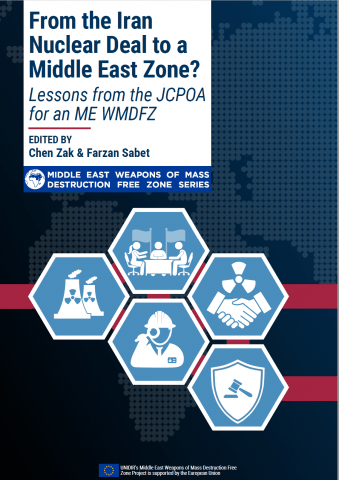
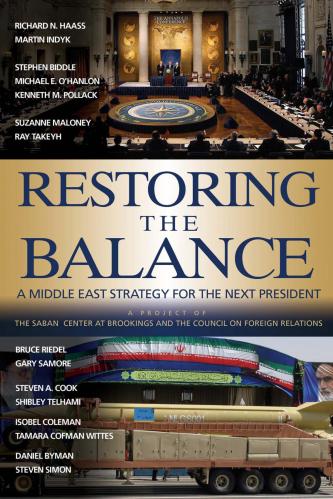
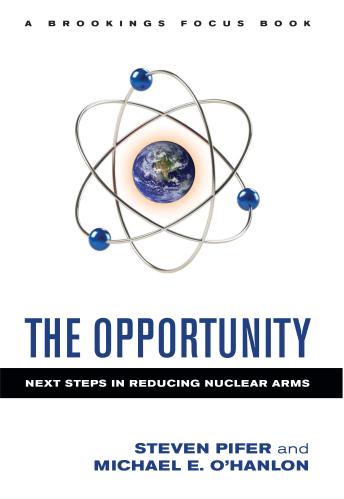
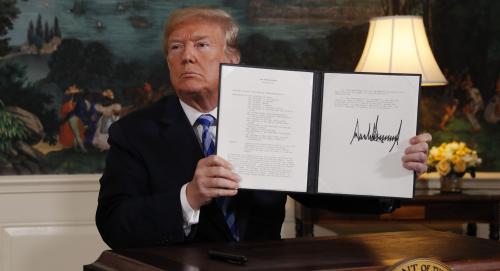
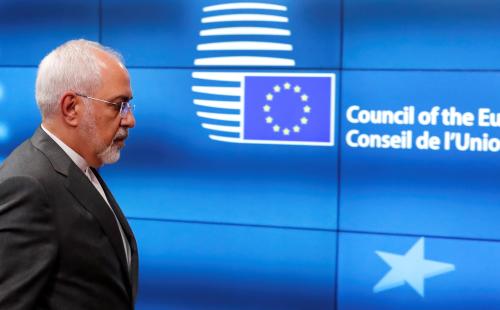
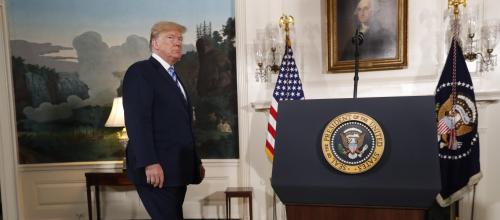

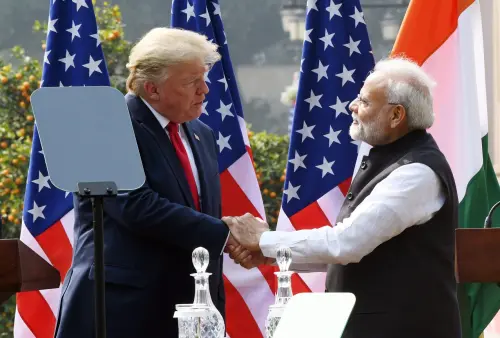
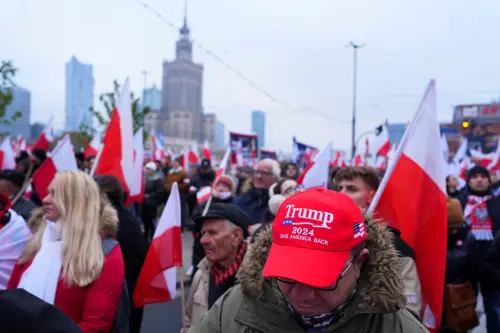
Commentary
In exiting the Iran deal, Trump left U.N. sanctions relief intact—why that could pose problems down the road
May 17, 2018